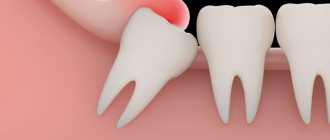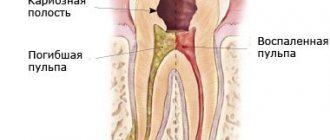- Why a temporary filling is placed: types of material
- Why does a tooth with a temporary filling hurt: the main reasons
- Standard activities after installation of the material
- Temporary filling hurts when pressed: how to cope with the disease
Many patients complain to dentists that their tooth hurts under a temporary filling. For the first 2-3 days, a slight aching pain is considered normal and does not cause cause for concern or panic. It is associated with the active influence of drugs on the nerve endings of the molar or premolar.
If the temporary filling hurts very strongly and for a long time when pressed, it is recommended to make an appointment with a specialist earlier than the specified date. Dentists at the reliable A-Medic clinic will conduct a thorough examination and prescribe a diagnostic examination to find out what exactly is causing the pain. All people are scared that they have had a temporary filling installed and their tooth hurts, but most often there is no reason to worry.
Why a temporary filling is placed: types of material
Non-permanent filling is a mandatory measure in the treatment of complicated carious lesions and root canal inflammation. It is required for medicinal treatment of an inflamed molar or premolar. It is entrusted with the protective function of the treated cavity from food ingress. Also, it prevents the medical pad from falling out.
The composition of such material differs significantly from a permanent filling. It can be made from water-insoluble or plastic components. The choice of the most suitable material directly depends on the condition of the molar or premolar and the purpose of the installation. Among the most common materials are:
- sympath. It can be of different shades - white (for filling non-pulp teeth) or light pink. The mass does not provoke irritation and other allergic reactions;
- dentin paste. It reliably protects the tooth from staining with amalgams and is characterized by water-repellent properties. The paste hardens in 100-120 minutes;
- zinc polyacrylate cement. It is characterized by good biocompatibility with tissues and high strength. The material is used for fixing prostheses (crowns) or filling (both permanent and baby teeth);
- Vinoxol. It is characterized by reliability and durability, capable of maintaining integrity for up to 4-5 months. The drug has antiseptic properties, which allows you to disinfect the tooth cavity. It hardens in 3-4 hours.
There are situations when the carious lesion did not have time to reach the nerve. In such cases, the molar or premolar is not depulped, but temporary material is installed. This is necessary for diagnosis to see whether the tooth will become sensitive or not. With the help of these measures, it is possible to completely preserve a molar or premolar (without removing the nerve) if the patient does not experience pain. If a pronounced reaction occurs (if the temporary filling hurts), the dentist will remove the nerve after placing a filling with arsenic.
Often, non-permanent filling is resorted to during prosthetics. This allows you to protect the molar or premolar from pathogenic microorganisms. The wearing period is individual and directly depends on the type of material and the reason why filling was required. It is installed by the attending dentist. On average, after 7-10, specialists replace it with a permanent filling. Sometimes, after applying a temporary filling, a tooth hurts; let’s figure out what could cause this phenomenon.
Why does a tooth with a temporary filling hurt: the main reasons
Often, patients with a temporary filling have a toothache when pressed. In some cases, such a reaction is considered normal. The attending physician will be able to answer for sure why a tooth hurts after a temporary filling after examining the oral cavity and conducting a diagnostic examination. Let's take a closer look at the main reasons for the appearance of pronounced discomfort sensations:
- Impact of the drug. If a tooth hurts with a temporary filling and medication, then most often the source of discomfort is its effect on the tissue. You should contact a specialist if the pain is pronounced and reduces the quality of life.
- Unfinished therapy. Often, after the pain has subsided, a person decides to stop therapy and does not come to an appointment to replace it with a permanent material. Temporary material is not intended to be worn for several years, so sooner or later it will fall out. It is recommended to replace at the appointed time.
- Allergic reaction to cementitious agent. If a tooth with a temporary filling aches and hurts a lot, the reason may lie in an allergic reaction. In such a situation, it would be more advisable to replace it with another cementing agent (depending on the period of wear).
- Lack of material. There is a high probability that it fell out while drinking or eating food, so external factors (irritants) come into direct contact with the soft tissues. An infection could have entered the tooth cavity, causing an inflammatory reaction.
- Prolonged wearing of the cementing agent (longer than the prescribed period). The material is quite fragile; when worn for a long time, it begins to lose its tightness, allowing pathogenic microorganisms (bacteria) to enter the cavity of the molar or premolar.
The biggest cause for concern is discomfort after installation of permanent material. This is an alarming signal that may indicate incorrect installation, untreated pathology, or emerging complications. In this situation, you need to make an appointment with a specialist to determine the main source of pain.
About root canal treatment at an appointment with a dentist
When diagnosing dental tissue pathology, the following steps must be taken:
- eliminate the causative factor;
- restore the tooth anatomically and functionally using restorative techniques or orthopedic devices.
The gums hurt after a filling, usually with conservative intervention in complicated forms of caries (pulpitis, periodontitis). Since the treatment of such forms is often combined with the use of a large number of small instruments and medications.
Filling stages:
- Administration of anesthesia : for pulpitis in each case. For periodontitis, depending on the clinical manifestations and stage of the process.
- Mechanical treatment of the affected cavity and opening of the roof of the pulp chamber.
- Cleaning canals from pulp and putrid masses using endodontic instruments.
- Antiseptic irrigation of canals : necessary for disinfection.
- Root filling.
- Crown restoration : restoration, orthopedic design.
Stages of mechanical and antimicrobial treatment of complicated forms of caries.
The root canal can be filled with temporary or permanent materials. Temporary substances are used to influence a specific link in the pathogenesis of the disease. After maintaining a certain time in the lumen of the canal (from 2 weeks to 6 months), the material must be replaced with a permanent one.
Temporary materials used:
- gangrenous pulpitis: antiseptics (Pulposeptin) are most often used;
- for periodontitis accompanied by destruction: calcium-containing preparations to stimulate bone restoration (Calcept).
There are several modifications to sealing the root space with material.
After closing the tooth cavity with a root filling, a filling (temporary or permanent) must be installed. The temporary one should be in the tooth cavity after applying the material to the canal for a short time, as well as after filling with permanent material. In the latter case, the choice of tactics depends on the clinic and the time of the specialist.
Standard activities after installation of the material
Do not drink or eat until the material has completely hardened, as it may crack or fall out completely. Also, food can get into the cavity of a molar or premolar. After a non-permanent filling, it is not recommended to eat soft food for the first 2-3 hours, and hard food for 10-12 hours. This will avoid a number of negative consequences. When chewing solid food in the future, you should use less of the side on which the filling was performed.
While wearing the material, hygiene rules must not be neglected. You should brush your teeth twice a day, and after eating, rinse your mouth with antiseptic solutions and floss. If the temporary material is installed for several months, it is recommended to use a brush with softer bristles during this period. To avoid possible complications, the material is removed on a strictly designated day.
Temporary filling hurts when pressed: how to cope with the disease?
People often ask the question: “if you have a temporary filling installed and your tooth hurts, what should you do?” When a tooth hurts under a temporary filling, this is a normal condition, do not panic. If the dentist said that there is no cause for concern, you should be patient and wait out the unpleasant symptom. When a temporary filling causes severe pain in a tooth, and you run out of strength to endure the pain, you can use the following recommendations:
- rinse your mouth with antiseptic and soothing solutions. You can prepare them yourself at home from natural ingredients. For example, chamomile and sage are poured with boiling water and the resulting product is used to rinse the mouth;
- do not allow food and drinks (mainly hot or cold) to come into contact with the treated tooth;
- take a painkiller (analgesic). “Nise” and “Ketorol” give good results;
- make lotions with valerian tincture. A moistened cotton swab of valerian is applied to the painful area, the gum near the tooth. This will temporarily relieve the irritation.
If a tooth hurts after installing a temporary filling and swelling or redness of the soft tissue appears, this may indicate the presence of an inflammatory process or the appearance of pus. In such a situation, you should re-make an appointment with a dentist-therapist. The A-Medic clinic employs qualified specialists with extensive experience. To make an appointment, just fill out the standard form on the official website of the clinic (indicating your full name and contact number). Prices are affordable, and consultation with a dentist is completely free.
A tooth hurts under an old filling: when do you need help from a dentist?
If the pain does not subside, you cannot do without a visit to the clinic. To make a correct diagnosis, the dentist needs to know all the symptoms associated with pain. The further method of treatment depends on the condition of the teeth and adjacent tissues. As a rule, the previous filling is removed, treated with antiseptics, and the canals are cleaned and sealed again.
After dental surgery, it is imperative to follow the doctor’s recommendations. They speed up the healing process and prevent new inflammations from developing. After applying the filling, it is not recommended to drink alcoholic beverages or excessively hot or cold food. Avoid sweets and solid foods. For the first two days, it is recommended to eat only soft foods and rinse your mouth after eating. Chew on the opposite side of the filled tooth for three days. You should brush your teeth gently and without pressure.
Even if the pain was there but has subsided, you should not postpone your visit to the clinic. Inflammatory processes may continue, and the pain will certainly return with even greater force.











